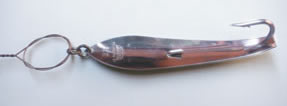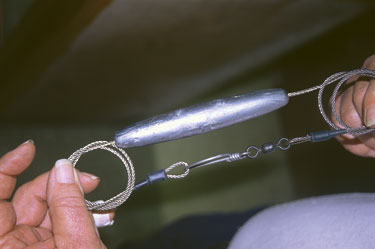January 01, 2006
By Steve Kantner
Dishing out reflections.

Deep-trolling rig: spoon like the one at top, rigged on mono or wire behind planer. |
Tradition has it that an angler was eating his lunch when he accidentally dropped a spoon overboard, and saw a northern pike strike it with gusto. True or not, we now know that the venerable wobbling spoon is one of the great all-time lures in both fresh and salt water.
With so many new trolling lures on the market these days, it's worth noting that spoons work as well today as they did 50 years ago.
It's hard to beat a properly presented spoon for kingfish, blackfin tuna, Spanish mackerel and bluefish. Even dolphin and the occasional billfish will take a crack at them. And there are special red-and-black versions that target wahoo.
Trolling spoons are categorized by their wobble; slimmer types generally have a tighter wobble and can be pulled fast. In the Huntington Drone series, the broader, even-numbered spoons have a broader wobble and work best at slower speeds. The 3 1/2 Drone with blue flash is a big favorite among South Florida anglers. “I stock as many as I can, but the charterboats keep cleaning me out,” said Scott Boyd of Boyd's Bait and Tackle in Fort Lauderdale.
The Clarkspoon, another coastal favorite, has a signature red bead on the head. It's a killer on Spanish and blues, and the smallest sizes are great for catching blue runners for bait; the tiny versions may imitate glass minnows or bay anchovies, the food of choice for a good part of the year for many green-water predators.

Highly reflective silver is very attractive to kingfish, blackfin tuna, and spanish mackerel. |
The Reflecto is another venerated spoon, though it's probably best-known for inshore fishing. It works great on reds, and there are many old-timers around Chokoloskee and up the west coast who will fish nothing else for snook. The No. 3 is also sometimes trolled in Everglades rivers with great success.
Whatever the spoon, there are some basic tactics needed to make them work best. While an inshore spoon being cast to shore might work fine with a direct tie to a mono shock leader, spoons used in trolling need some special rigging.
Line twist is the major bugaboo on nearly all spoons, but particularly those used in trolling. One approach is to rig a keel sinker ahead of the spoon. The keel runs true through the water, blocking any twist, and the bead chain running through the sinker is in reality a series of small swivels that let the twist bleed off.
The problem with keel sinkers is that sometimes toothy fish think they look good enough to eat; they bite them off, and with them your spoon. And sometimes, when water is clear and calm, the keel sinkers may slow the bite on some species.
Other possibilities are to fish the spoon behind a planer or downrigger ball, using ball-bearing swivels at the front and rear of the leader to get rid of twist. Of course, with these larger depth-control devices, you usually have to get the spoon well away from the device to draw many strikes—12 feet is the minimum, and some guys go as much as 100 feet in clear water.
You'll often rig spoons with wire. When you do, be sure to hang them on a reinforced wire loop, which is made by weaving the wire through the spoon's eye or ring twice before forming the haywire twist. If you wire them up without the loop, action is greatly reduced, and so are the number of strikes. Many experienced trollers simply use 80- or 100-pound-test monofilament leader, running off a planer. It's more flexible, less visible and generally safe, as kingfish tend to bite the aft end of a trolling spoon.
Every spoon has an optimum trolling speed on a given rig; it's up to you to find that speed. You know the spoon is working best when there's an evident throb in the rodtip. Both the speed of the boat and the length of line you have out can affect this speed, so experiment until you get it right for the spoons you're running.

Toothy fish sometimes strike trolling sinkers, which is why a trace of cable is a good idea. |
Most trolling spoons are single-hook lures, and some of them come out of the box rather blunt on the tip. Be sure to give them a few licks with the file before putting them over the side, particularly on larger models. And never use the spoon as a lifting lever to hoist a fish aboard; too often, either the spoon or the hook will bend, and this ruins the action.
Finally, size your spoons to the predominant baitfish likely to be the target of the fish you're after. This can be anything up to 12 inches long, so don't ignore the spoon just because you're after offshore heavyweights. Spoons are moderately priced, durable and effective, and they're likely to last a lot longer than they already have as dependable bluewater fish magnets.
FS

